-
Categories
-
Pharmaceutical Intermediates
-
Active Pharmaceutical Ingredients
-
Food Additives
- Industrial Coatings
- Agrochemicals
- Dyes and Pigments
- Surfactant
- Flavors and Fragrances
- Chemical Reagents
- Catalyst and Auxiliary
- Natural Products
- Inorganic Chemistry
-
Organic Chemistry
-
Biochemical Engineering
- Analytical Chemistry
-
Cosmetic Ingredient
- Water Treatment Chemical
-
Pharmaceutical Intermediates
Promotion
ECHEMI Mall
Wholesale
Weekly Price
Exhibition
News
-
Trade Service
!--., September 23, 2020 // --- / Myotonic dystrophy type I (DM1) is the most common adult pathogenic muscular dystrophy type I (DM1).
people with the disease inherited duplicate DNA fragments, leading to the toxic build-up of repetitive RNA.
, people born with myotrophy experience progressive muscular dystrophy and weakness, among other symptoms of weakness.
CRISPR-Cas9 is an increasingly used technique for correcting genetic (DNA) defects that cause various diseases.
years ago, researchers at the University of California, San Diego School of Medicine changed the direction of the technology: modifying RNA in a way they call RNA-targeted Cas9 (RNA-targeting Cas9, RCas9).
a new study, the researchers confirmed that a dose of RCas9 gene therapy degrades toxic RNA and almost completely reverses the symptoms of the model of mice with strong muscular dystrophy.
results were published online September 14, 2020 in the journal Nature Biomedical Engineering under the title "The sustained expression of Cas9 targeting toxic RNAs reverses disease phenotypes in mouse models of myotonic dystrophy type 1".
photo from Nature Biomedical Engineering, 2020, doi:10.1038/s41551-020-00607-7.
"Many other serious neuromuscular diseases, such as Huntington's disease and amyotrophic lateral sclerosis (ALS), are also caused by similar accumulations of RNA," said Dr. Gene Yeo, co-author of the paper and professor of cellular and molecular medicine at the University of California, San Diego School of Medicine.
there is no cure for these diseases.
" in general, CRISPR-Cas9 works by guiding an enzyme called Cas9 to cut a specific target gene (DNA), allowing scientists to instil or replace the target gene.
works similar to RCas9, but Cas9 is directed to an RNA molecule, not DNA.
a 2016 study, Yeo's team used RCas9 to track RNA in living cells to prove that RCas9 worked.
in a 2017 study of laboratory models and cells from patients, the researchers used RCas9 to eliminate 95 percent of abnormal RNA associated with myotrophy type I and type 2, an ALS type, and Huntington's disease.
new study further advances RCas9 therapy, which reverses the symptoms of the disease in live models of type I mice with myotrophy.
this method is a gene therapy.
the researchers packaged RCas9 in a non-infectious virus vector that delivers the RNA cutting enzyme to cells.
the mice were injected with a single dose of RCas9 gene therapy or mock treatment (mock treatment, which refers to an unpackaged viral vector of RCas9).
RCas9 reduced abnormal repetitive RNA by more than 50 percent, varying from tissue to tissue, and after treatment in mice with strong muscular dystrophy became essentially the same as healthy mice.
, the researchers were concerned that the RCas9 protein from the bacteria might cause an immune response in mice to be quickly removed.
then tried to briefly suppress the mice's immune system during treatment.
results, they were surprised and delighted to find that they had prevented immune response and removal in mice, allowing the virus vector and the RCas9 cargo it carried to persist to play their therapeutic role.
, they showed no signs of muscle damage.
, they observed an increase in the activity of genes involved in new muscle formation.
Yeo said, "This opens the door to starting testing CRISPR-Cas9 for targeted RNA as a potential treatment for other human genetic diseases--- at least 20 diseases are caused by the accumulation of repetitive RNA.
remains to be seen whether RCas9-based therapies will work in humans or whether they will cause harmful side effects, such as an unwelcome immune response.
such preclinical studies will help these researchers identify potential toxic side effects and assess the effects of long-term exposure.
2017, Yeo co-founded a company called Locanabio that accelerates the development of RNA-targeted CRISPR-Cas9 through preclinical testing and accelerates to clinical trials for the treatment of acute muscular dystrophy and other potential diseases.
(bioon.com) Reference: 1. Ranjan Batra et al. The sustained expression of Cas9 targeting toxic RNAs reverses disease phenotypes in mouse models of myotonic dystrophy type 1. Nature Biomedical Engineering, 2020, doi:10.1038/s41551-020-00607-7.2.Twist on CRISPR gene editing treats adult-onset muscular dystrophy in mice !-- title.







